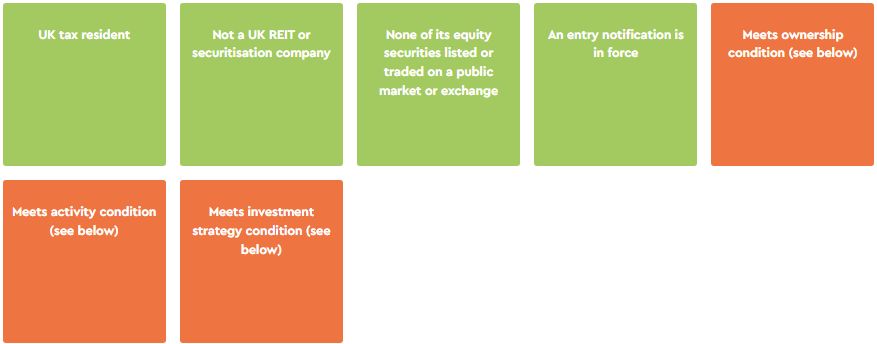Summary
Since April 2022, the UK has had a new tax efficient vehicle – the qualifying asset holding company (or QAHC). This is a key change in the UK's tax strategy for asset management, part of a wide-ranging review into the UK funds landscape being carried out by the government, designed to enhance the UK's attractiveness to the sector. The QAHC allows the UK to compete with vehicles on offer in rival European fund centres, in particular Luxembourg and Ireland. Its availability is particularly welcome for many managers who have been concerned about the need to build substance in Luxembourg, especially in the light of the ATAD III proposals.
Essentially, QAHCs are normal unlisted UK tax resident investment companies that are at least 70% owned by "good" investors ("Category A investors"), such as investment funds and various types of institutional investor (e.g. most pension funds and many insurance businesses).
In addition to allowing Category A investors to invest tax efficiently in shares, debt and overseas land, the QAHC regime includes benefits that apply to the tax position of the individuals managing them (with provision of returns in capital (rather than income) form being facilitated and, for non-domiciled managers, the availability of the remittance basis of taxation being extended). QAHCs can be used in a number of situations, including in credit fund structures and as master holding companies.
The government consulted widely with industry working groups (which included individuals from our Tax Team) when designing the regime and two key messages it received were that, to be successful, the regime must (i) provide generous tax benefits and (ii) be simple to use.
Generous tax benefits
The wide-ranging tax benefits include a broad exemption from tax on gains from shares (other than in UK property rich companies) and non-UK land, a deductions regime that should keep taxable income very low (by giving deductions for profit-related interest) and a complete exemption for foreign property business income. In addition, there are tax benefits for investors, with normal tax rules disapplied to make it easier for returns from the QAHC to be passed to investors in capital form.
Simplicity
There are areas of detail in the rules but, once worked through, for most investors, managers and strategies the regime should be straightforward to apply.
High levels of market interest
In the time the regime has been in force, we have seen much client interest from both asset managers and investors.
This briefing is intended to be a helpful guide to the regime, providing an overview of the eligibility requirements and tax benefits, as well as discussing how it compares with Luxembourg's rival offering. For those interested in finding out more about how the QAHC could be used in their businesses please contact us - our details are at the end of this briefing.
Key tax benefits of QAHC regime
Tax feature |
Overview |
|
Exemption for gains on shares and overseas land |
Complete exemption for gains for overseas land and "qualifying shares" (broadly, all shares apart from those deriving at least 75% of their value from UK land). |
|
Low taxable income (see below for overseas property business income) |
Profit participating loans allowed to reduce taxable income such that QAHC only taxed on amount proportionate to value of its "ring fence" activities (broadly, investment activities in relation to qualifying shares, overseas land, debt and related derivative contracts). |
|
Exemption for overseas property business income |
Complete exemption from corporation tax on profits of an overseas property business to the extent profits are chargeable to tax abroad. Also applies to related loan relationships and derivatives. |
|
No withholding tax on interest paid |
No withholding tax on interest paid by a QAHC. |
|
Exit market value uplift |
Deemed uplift to market value on exit of certain ring fence assets (including qualifying shares and overseas land). |
|
Capital returns to investors |
Ability to make capital returns to investors to be facilitated by switching off tax rules that treat premiums on share buy-backs as distributions. Does not apply to employment related securities held by persons other than fund managers. |
|
Stamp taxes |
No stamp taxes on share or loan note repurchases. |
|
Enhanced remittance basis for managers |
Remittance basis available to non-domiciled managers for non-UK source QAHC returns (despite QAHC being a UK resident company). |
Other important tax consequences of being a QAHC
As the government was concerned that it will lose out on tax on existing latent gains, existing companies electing into the QAHC regime are deemed to have disposed of certain ring fence assets for market value on joining the regime. However, an extended version of the substantial shareholders exemption is available which, in many cases, will prevent any tax charge arising.
Various provisions prevent the regime benefitting non-ring fence activities, for example, it is not possible to carry out tax neutral intra-group transfers of ring fence assets from a non-QAHC to a QAHC or to surrender ring fence losses from a QAHC to a non-QAHC. This latter point may mean that QAHCs are not commonly used in leveraged private equity "acquisition stacks" for UK portfolio companies, as a QAHC's losses from financing costs cannot be used to relieve trading profits in the underlying companies.
QAHCs are also subject to a more stringent application of the UK transfer pricing rules (TP), with the exemption for small and medium-sized entities disapplied and all investors (irrespective of the size of their holding), and indeed certain of their associates, deemed to have an interest in the QAHC sufficient to satisfy the "participation" requirement. Clearly the government thinks it is possible for a QAHC to issue profit participating loans that leave it with a very low taxable profit and also satisfy TP rules.
There are additional reporting requirements with which QAHCs have to comply, such as the need to provide an estimate of the market value of the QAHC's ring fence assets at the end of each accounting period.
Eligibility criteria
There are seven eligibility requirements. Four of these are very straightforward but the other three contain a little more complexity and are discussed below.

The activity condition
Essentially the main activity of the company must be the
carrying on of an investment business, and the other activities of
the company must be ancillary to the carrying on of that business,
and not carried on to any substantial extent.
A potential issue with the activity condition is that it requires
investors to determine whether the QAHC is investing. For most
investment strategies this should not be problematic, although
there are some grey areas. When the regime was first introduced
there were fears that this issue would particularly discourage
credit funds from using it, but HMRC took on board industry
feedback and, in a welcome move, subsequently provided helpful
guidance that has alleviated much of the concern.
The investment strategy condition
The company's investment strategy must not involve the
acquisition of equity securities listed or traded on any public
market or exchange (or interests whose value derives from such
securities), otherwise than for the purpose of facilitating a
change of control of the issuer that results in the securities no
longer being so listed or traded.
The change of control exclusion should facilitate "take
privates". In addition, "lock-up" periods following
an IPO (when the seller is temporarily required to hold on to some
shares in the listed company) should not cause a breach.
It is possible for a company to, in effect, elect out of the
investment strategy condition (provided certain conditions are
met). However, if such an election is made, the corporation tax
exemption that usually applies to distributions received by a
company is switched off for its listed or traded equity
securities.
The ownership condition
The ownership condition limits, to 30%, the size of
"relevant interests" that "non-Category A
investors" can have in the QAHC or in any enhanced class of
the QAHC's securities (i.e. securities that entitle holders to
a greater proportion of the company's profits or assets of a
particular class).
NB: This is not quite the same thing as saying Category A investors
must own at least 70% of the QAHC, as, due to the way that
"relevant interest" are calculated, it is possible for
both non-Category A investors to hold more than 30% and Category A
investors to hold at least 70%.
Category A investors
Category A investors include a range of institutional investors
such as most pension funds, charities and authorised long-term
insurance businesses. Investment funds that are "qualifying
funds" are also Category A investors. Broadly, these are (i)
"collective investment schemes" (CISs) or
"alternative investment funds" (AIFs) for regulatory
purposes that either are not close (broadly, controlled by five or
fewer persons) or are 70% controlled by Category A investors, and
(ii) CISs, and many corporate AIFs, that meet the "genuine
diversity of ownership" condition (GDO).
For the GDO to be met a fund must be sufficiently widely marketed.
As HMRC consider the GDO to be a one-off test (whereas the
non-close and 70% tests require on-going monitoring), it is,
arguably, the most advantageous condition to meet. However, prior
to Royal Assent of the Finance (No.2) Act 2023 on 11 July 2023,
this was not open to most funds that are corporates as, under the
original rules, the GDO test was only available to CISs – and
corporates cannot be CISs (unless they are open-ended investment
companies or limited liability partnerships). Helpfully, from that
date, it has been possible for a corporate fund to satisfy the GDO
provided that its corporate status is the only reason that it is
not a CIS. This change also has limited retrospective effect back
to the start of the QAHC regime for corporate funds that had made
an otherwise ineffective entry notification (by relying on the
GDO).
In another improvement to the rules, since 11 July 2023 it has been
possible for the GDO to be satisfied by reference to
"multi-vehicle arrangements". Essentially, this allows
the test to be considered in the context of the entities making up
the "fund" as a whole (rather than on an entity-by-entity
basis) and so is helpful in relation to parallel and aggregator
vehicles.
Managed accounts for Category A investors structured as limited
partnership "funds of one" should be able to hold QAHCs
(even if they are not "qualifying funds"). This is
because, for the purposes of calculating the size of relevant
interests, the regime treats limited partnerships that are not
"qualifying funds" as transparent and contains special
provisions that, essentially, disregard, for those purposes, a fund
manager's priority profit share and any voting rights in the
QAHC that it might have by virtue of being the general partner of
the fund.
QAHCs are Category A investors, which means that you can stack
QAHCs.
In addition, companies that are at least 99% owned by Category A
investors (other than QAHCs) are themselves eligible investors
provided they meet the activity condition. This potentially allows
a Category A investor to hold its interest in a QAHC through a 99%
subsidiary.
Other Category A investors include UK REITs (and overseas
equivalents) and persons exempt from corporation tax or income tax
(as relevant) on the grounds of sovereign immunity.
Category A investors do not include individuals or
"normal" companies.
Which investors are Category A investors?

Relevant interest
A person has a "relevant interest" if, broadly, they
are beneficially entitled to a company's profits of its ring
fence business available for distribution or assets of that
business available for distribution on winding up, or if they have
voting power in the company in relation to "standard
resolutions".
When assessing whether a person has a relevant interest you
generally only look at direct interests. The exceptions to this are
indirect interests held directly through other QAHCs and where a
complex "anti-fragmentation" rule applies. Broadly, that
rule operates to aggregate the different interests of a direct
investor in the QAHC (or an investor who holds solely through one
or more other QAHCs) who also has a stake in any other
investor.
Generally, when calculating relevant interests, you do not look
through transparent "qualifying funds" (so, for example,
a QAHC could be 100% owned by a qualifying fund that is a limited
partnership whose entire investor base consisted of non-Category A
investors). However, this principle is disapplied where the
anti-fragmentation rule applies.
Carried interest held directly in the asset holding company (or
through a transparent entity that is not a qualifying fund) is
deemed to give holders a proportionate entitlement equal to the
highest percentage they could be entitled to under the carry
arrangements over the life of the arrangements. This has the
advantage that any "catch up" period (when fund managers
are entitled to the entirety of a fund's profit) should not
prevent the ownership condition being met, but it has the
disadvantage that the relevant interest calculation has to assume
that managers get their full carried interest entitlement
regardless of whether or not they actually do so.
QAHC regime: comparison with Luxembourg
|
Area |
Luxembourg |
QAHC regime |
Winner |
|
Eligibility criteria |
No specific holding company eligibility criteria |
Eligibility criteria must be met but should generally be straightforward where 70% Category A investors |
Luxembourg |
|
Taxation of gains |
Participation exemption subject to simple conditions |
Simple and wide-ranging exemption from capital gains on most shares (provided not UK land rich) and overseas land |
UK |
|
Taxation of dividends |
Participation exemption subject to simple conditions |
Generally exempt (but not in relation to listed or traded equity securities if the QAHC has elected to disapply the investment strategy condition). |
Position in both jurisdictions is pretty good |
|
Taxation of income |
Taxed at full rates, but only on transfer priced margin. Hybrid rules apply in principle, but effective carve out for funds with no single investor with more than 10% |
Taxed at full rates, but only on transfer priced margin for ring fenced activities with deductions for profit related interest. Hybrid financial instrument rules and late-paid interest rules disapplied. Group relief cannot be surrendered outside of ring fence. |
Group relief switch off is problematic for QAHC use in leveraged private equity "acquisition stack" |
|
Withholding tax (WHT) on interest |
Generally no interest WHT |
Exemption for payments of interest by QAHC |
Position in both jurisdictions is pretty good |
|
WHT on dividends |
WHT generally applies but typically returns can be structured not to be dividends |
None (i.e. same position as for most UK companies) |
UK |
|
Capital returns for UK investors |
Easy – e.g. redemption of alphabet shares for partial liquidation |
Usual tax treatment of share repurchases as distributions switched off for QAHCs, so capital treatment potentially available. But UK company law potentially problematic. |
Luxembourg - simpler |
|
Use as cross-border asset holding company |
Good treaty network and access to EU directives, but see substance concerns below |
Good treaty access. No access to directives. |
Luxembourg directive access balanced out by substance concerns |
|
Substance |
Investee jurisdictions are increasingly questioning Luxembourg holding company entitlement to treaty / directive benefits |
In principle it should be easier for human and technical resources to reside in UK. |
In principle UK should have the advantage |
Originally published 10 May 2023
The content of this article is intended to provide a general guide to the subject matter. Specialist advice should be sought about your specific circumstances.







